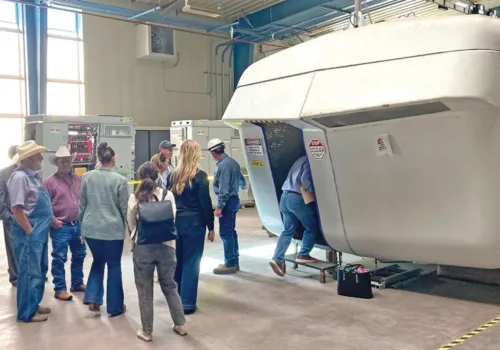
TUCUMCARI – A recent report presented to New Mexico's Legislative Finance Committee (LFC) has spotlighted the dramatic escalation of construction costs at public colleges and universities across the state, with Eastern New Mexico University (ENMU) serving as a key case study.
During three days of meetings in northeast New Mexico, LFC analyst Rhea Serna briefed lawmakers on the financial pressures facing higher education construction. According to Serna, the average cost of new construction at New Mexico’s colleges rose sharply from $520 per square foot during the 2022 general obligation bond cycle to $1,038 per square foot in 2024. That figure is projected to jump again to $1,312 per square foot in 2025. Meanwhile, the state's capacity to fund such projects has increased by only 12% in that period.

As a prime example of this trend, Serna pointed to ENMU’s planned Student Academic Services building. Initially estimated at $660 per square foot, the project’s revised cost now stands at $1,194 per square foot — an 81% increase. The total cost has ballooned from $16.2 million to $31.3 million, prompting the university to request and receive additional state funding.
The cost surge has been attributed to a confluence of factors, including rising construction demand, limited skilled labor, and inflationary pressure in the post-pandemic economy. The project’s design, which includes a brick façade and stone veneer to match surrounding campus buildings, was also cited as a major contributor to the increase.
"A potential explanation for the escalated brick and masonry costs might be due to subcontractor worker per diem housing expenses, however the estimator could not verify this due to insufficient documentation in the general contractor's budget," the LFC report stated.
Among the most striking individual line items, the building's climate-control system experienced a 350% cost increase, adding $145,000 to the total. Ceramic tile costs nearly doubled from $175,000 to $326,000. Meanwhile, concrete work and steel framing each added $250,000, and brick and masonry units contributed an additional $300,000.
An early proposal to reduce the building’s square footage in order to lower costs was rejected after it was determined that such a change would impair the building’s intended functionality. However, later assessments revealed that the climate-control and lighting systems were oversized, contributing to $1.7 million in avoidable costs.
The report also noted that architectural and engineering fees for the ENMU project soared from $799,000 to $3.6 million — a 351% increase — largely due to inflation and scope changes during the extended planning and design phase.
John Houser, ENMU's associate vice president of public relations and advancement, emphasized the impact of broader economic forces on the project’s timeline and budget. “The project was proposed in the Summer of 2021, by the time we were able to issue the construction contract in October 2024, the cost of construction had nearly doubled from $12 million to $24 million,” Houser said in an email. He added that the pandemic-induced supply chain challenges and inflation were key drivers of the increases.
The university’s vice president of administration and finance, Tony Major, worked closely with the LFC on the findings, Houser said.
Serna’s report also looked at other institutions’ capital projects. Western New Mexico University’s Early Childhood Facility saw its projected costs rise from $15.7 million to $22 million. On the other hand, New Mexico Junior College (NMJC) in Hobbs was commended for keeping construction expenses in check during its Heidel Hall renovation, with costs held to $668 per square foot.
Charley Carroll, NMJC’s vice president of operations, was singled out for praise. Carroll’s multiple construction-related licenses have allowed him to closely scrutinize contractor bids and negotiate effectively, according to the report.
Serna concluded by recommending that institutions adopt more rigorous oversight strategies, such as hiring independent cost estimators to review project budgets, identify overpriced items, and propose engineering alternatives.
State Rep. Rebecca Dow, R–Truth or Consequences, voiced sharp criticism of the price escalation, particularly the architectural fees. She called the increases “almost criminal.”
State Sen. George Muñoz, D–Gallup, stressed the need for stronger legislative oversight. “The only way we’re going to contain costs is oversight,” he said. “There’s got be cost containment, and nobody’s watching... The Legislature is going to have to stand up for itself.”
In a separate session, Mesalands Community College President Allen Moss provided an update on the school’s financial turnaround. Just two years ago, the college was in such dire straits that it was unsure whether it could meet payroll.
“Our financial picture has vastly improved,” Moss told lawmakers. He said that Mesalands returned between $150,000 and $170,000 in unused state funds for fiscal year 2024 and expects to return between $800,000 and $1.2 million from a state emergency appropriation issued in 2023. He anticipates a surplus for fiscal year 2026.
Moss credited the college’s staff for weathering the crisis and helping to stabilize operations. “I see the future of Mesalands is serving the community, especially with the workforce,” he said.
The college is expanding key programs in welding and commercial driver training and is introducing wind technician training at the Santa Rosa prison. It also received $625,000 in recurring and one-time funding to grow its nursing program. Moss said Mesalands is now building partnerships with institutions like ENMU-Ruidoso, Clovis Community College, and New Mexico State University to expand offerings in agriculture and technical fields.
One persistent challenge is the lack of student housing. Most students are currently housed in rentals or motels. However, Moss said that Tucumcari Public Schools has offered land near campus to help the college pursue new housing developments.
Committee members concluded their visit by touring the Mesalands campus, including its wind technology training center.
Originally reported by Ron Warnick in The Eastern New Mexico News.